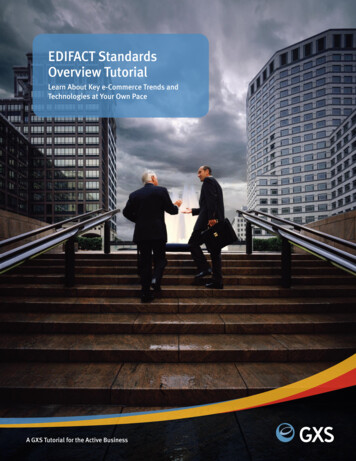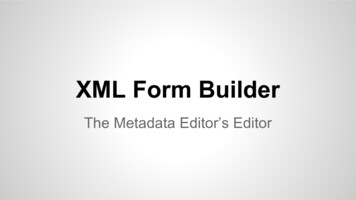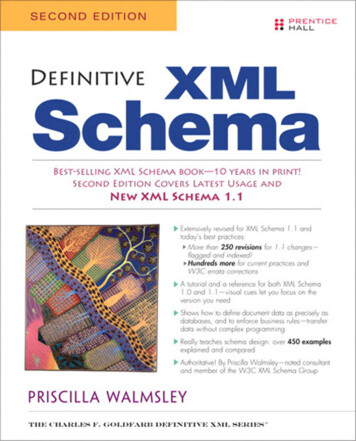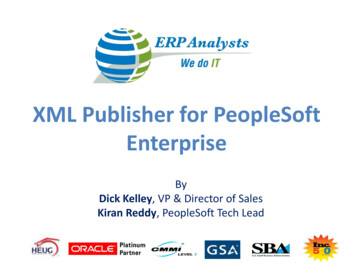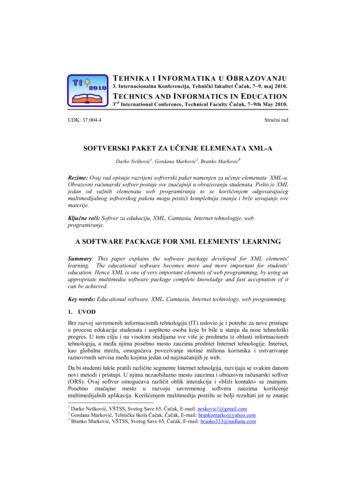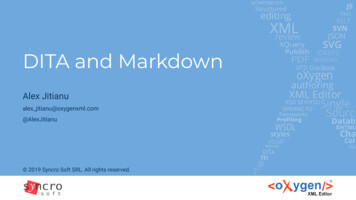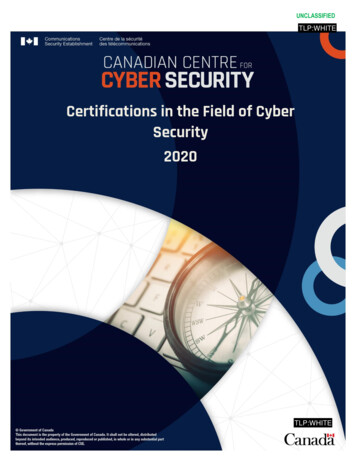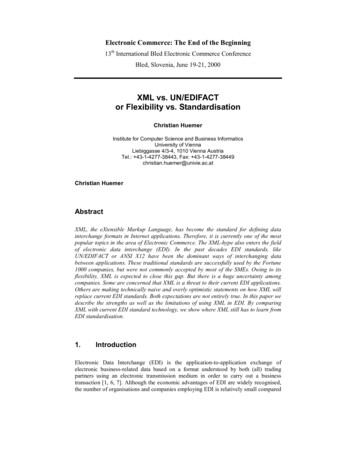
Transcription
Electronic Commerce: The End of the Beginning13th International Bled Electronic Commerce ConferenceBled, Slovenia, June 19-21, 2000XML vs. UN/EDIFACTor Flexibility vs. StandardisationChristian HuemerInstitute for Computer Science and Business InformaticsUniversity of ViennaLiebiggasse 4/3-4, 1010 Vienna AustriaTel.: 43-1-4277-38443, Fax: ian HuemerAbstractXML, the eXtensible Markup Language, has become the standard for defining datainterchange formats in Internet applications. Therefore, it is currently one of the mostpopular topics in the area of Electronic Commerce. The XML-hype also enters the fieldof electronic data interchange (EDI). In the past decades EDI standards, likeUN/EDIFACT or ANSI X12 have been the dominant ways of interchanging databetween applications. These traditional standards are successfully used by the Fortune1000 companies, but were not commonly accepted by most of the SMEs. Owing to itsflexibility, XML is expected to close this gap. But there is a huge uncertainty amongcompanies. Some are concerned that XML is a threat to their current EDI applications.Others are making technically naive and overly optimistic statements on how XML willreplace current EDI standards. Both expectations are not entirely true. In this paper wedescribe the strengths as well as the limitations of using XML in EDI. By comparingXML with current EDI standard technology, we show where XML still has to learn fromEDI standardisation.1.IntroductionElectronic Data Interchange (EDI) is the application-to-application exchange ofelectronic business-related data based on a format understood by both (all) tradingpartners using an electronic transmission medium in order to carry out a businesstransaction [1, 6, 7]. Although the economic advantages of EDI are widely recognised,the number of organisations and companies employing EDI is relatively small compared
Christian Huemerto the total number of businesses worldwide. This is due to the fact that the costs forsetting up and running an EDI relationship are too high for SMEs. Many people blamethe complexity included in current EDI standards, like UN/CEFACT or ANSI X12, forthe limited success of EDI.In contrast to EDI, the World Wide Web (WWW) has become a successful platform forconducting business electronically. End-consumers as well as SMEs find it convenientto perform business transactions by completing an electronic form, which can beautomatically processed by the business partner. In the early days of the WWW, theinformation exchange was most commonly based on the common gateway interface(CGI) which allows the structured transfer of the content of an HTML form to the serverwhere it is processed by a scripting language. Nevertheless, HTML based electroniccommerce includes some shortcomings [2]: It is always necessary to load an entirepage. This is not comfortable in cases where a stable template remains and only portions(e.g. resulting from a dynamic query) have to be changed. Furthermore, the quality ofWWW searches could be improved. For example, to specify search criteria for aselected price range is effectively impossible, because there is no way to mark a stringof digits as price.The eXtensible Markup Language (XML) is designed to overcome the above mentionedshortcomings of a pure HTML approach [11]. As opposed to HTML tags referring tothe presentation of data XML tags are used to describe what the information is about.Accordingly, XML makes it possible to encode information with meaningful structureand semantics in a notation that is both human-readable and processable by computers.Due to the fact that XML files could (under given circumstances) be automaticallyprocessed by computers, XML is proposed as an alternative for the application-toapplication exchange of data [14].Over the last two years many XML-based applications appeared. First success stories,like that of RosettaNet, underpin the XML strengths in the EDI area. The enthusiasm forXML created unrealistic public expectations about XML’s potential to change theworld. But XML, while quite powerful in terms of generality and flexibility, is not byitself a solution to any modelling or computing problem [4]. XML’s flexibility providesfor a fast and unbureaucratic way of defining XML-based interchange formats betweenbusiness partners. However, these interchange formats are limited to a closed usercommunity, and are most likely to be incompatible to others.It must be realised that XML has to offer a lot of goodies for EDI, but employing XMLalone does not guarantee for a plug-and-play solution in application-to-applicationinformation exchange. But it was the „easy-to-use“ approach which made up the successof the Internet. A similar success in EDI could only be reached, if there were no needfor an agreement on the meaning of XML tags (cf. Open-edi [10]).Thus, we analyse the areas where XML is superior to current EDI standards.Furthermore, we show the current limitations of XML-based approaches and wherethese approaches can learn from EDI standardisation to help realising the „Open-edi“vision [9] in which companies could exchange messages to conduct electronic businessin a completely ad-hoc fashion, with minimal prior agreements. However, it must berecognised, that the pure combination of XML and EDI strengths will not lead to anOpen-edi environment, because XML is nothing more than a syntax that could be usedin the functional service view (FSV). But using the enthusiasm about XML to designcarefully the message flows in dialogues between applications on the basis of thebusiness needs (business operational view) before transforming them into XML syntaxwill be a step into the right direction.
XML vs. UN/EDIFACT or Flexibility vs. StandardisationThe remainder of the paper is structured as follows: In Section 2 we give an overview ofthe approaches to structure information in an interchange file for both UN/EDIFACT asrepresentative of traditional EDI standards and XML. The advantages and disadvantagesof using XML for EDI are presented in Section 3. Section 4 presents requirements to bemet in the future in order to enable a global data interchange based on XML. Finally,Section 5 concludes with a short summary.2.Approaches to Information StructuresIn order to exchange data between applications, it is essential that the applications knowwhat the data is all about. A data format specifying how data are to be representedensures the identification of data values. In addition, the meaning of the data valuesmust be defined to exchange electronic data across organisational boundaries in such away that no human intervention for its interpretation is required. EDI standards mustcover both syntax and semantics. Over the past decades various EDI standards havebeen developed: Proprietary formats, sector specific solutions and branch-independentstandards like X12 and UN/EDIFACT. But all these „traditional“ standards use thecommon concept of implicit data identification, which differs from the taggingmechanism used in XML. The following two subsections present the different methodsof ensuring the correct interpretation of information by information systems.Current EDI Standards (UN/EDIFACT)Since most of the current EDI standards usea similar method to ensure machineinterpretation and describing all of themwould involve a lot of redundancy, we haveselected UN/EDIFACT as representative forthe current EDI standards. UN/EDIFACT isdesigned to be an international and branchindependent standard. Its syntax has beenadopted as ISO standard 9735 in 1987. In1988 the UN/ECE agreed to maintain theUN/EDIFACT message types.UN/ EDIFACT is based on the followingkey concepts: Messages, Segments, DataElements and Codes. Standardised Codesare used for representation of businessterms. Data Elements are the smallestindivisible pieces of data. Furthermore,UN/EDIFACT uses the concept ofcomposite data elements, which aresequences of simple data elements that alltogether describe one logical unit. Segmentsare groups of related data elements. Amessage is a sequence of segments andsegment groups representing a specificbusiness transaction. This hierarchicalFigure 1: UN/EDIFACT Structure
Christian Huemerstructure which is used in an UN/EDIFACT interchange is depicted in Figure 1.Taking a closer look at Figure 1, it is easy to detect that UN/EDIFACT takes advantageof a delimiter-based syntax: The data values are separated from each other by specialcharacters („:“, „ “, etc.). This allows for flexible length of data values.Of great significance is the fact that UN/EDIFACT is based on implicit dataidentification. Accordingly, the meta information (the meaning of a data value) is notexplicitly stated in an interchange. The semantics of a data value are given by itsposition in the message. Consequently, simple data elements within a composite dataelement, data elements within a segment, as well as segments in segment groups andmessages must follow a predefined order. This order is defined in the message typedefinitions that are maintained by the UN/ECE and published twice a year inUN/EDIFACT directories. To ensure a common understanding of transmitted datavalues both business partners must be aware of the corresponding message typedefinition.Although the right interpretation of transmitted values is the main function that an EDIstandard must ensure, EDI standards cover also the following two topics: businessknowledge caption and agreed code lists. Each UN/EDIFACT message type is a datamodel for a business transaction. It is created by volunteers from the business worldwho put their business sector know-how into a data model which is written down inUN/EDIFACT notation [15]. As a result an UN/EDIFACT message type is a data modelthat is intended to capture all semantics that may appear in a corresponding businesstransaction type. But the careful analysis to create an UN/EDIFACT standard messagetype also results in a serious drawback, because the standardisation process is timeconsuming. The usage of agreed code lists is also crucial for the UN/EDIFACTapproach, since free text statements are not well suited for further processing by amachine.XMLXML is a W3C standard since February 1998, but the development of XML startedalready in 1996. Nevertheless, XML is not a new technology. In fact, XML is a subsetof the ISO standard 8879 SGML (Standard Generalized Markup Language), which wasdeveloped in the beginning of the 80 s and approved in 1986. SGML has beensuccessfully used in large applications of publishing companies. But SGML is quitecomplex and includes many features that are not of first priority in Internet applications.Therefore, XML has been designed to use 20% of SGML s features to get 80% ofSGML s functionality.XML is a markup language using tags and attributes to mark data. But XML is not ascreen-formatting language like HTML. XML itself does not even care aboutpresentation. XML is designed for more intelligent applications where the meaning ofdata and not (only) its presentation is crucial –, as it is the case for EDI.XML is a language to describe structured data in a way that the information is selfexplaining. Therefore, XML is more than a language; it is a meta language [3]. Itdefines the syntax rules for creating the markup languages for encoding instances ofparticular document or message types. One of the most important syntax rules for XMLis that markups principally consist of a start tag and an end tag (in contrast to HTML).Furthermore, tag pairs can be nested within others to an unlimited degree. These tworules imply a tree-structure on so called well-formed XML documents. When designinga new XML language, the document structure – which tags are allowed and how tagged
XML vs. UN/EDIFACT or Flexibility vs. Standardisationelements are nested – is usually defined in a Document Type Definition (DTD). Figure2 shows an example DTD and an XML file based on this DTD.Since XML is a meta language, everyone can design a new language (or DTD) forhis/her own purpose. Everyone is allowed to define his/her XML tags to delimit the data[12]. The interpretation of the data is completely left to the application that processes it,but is always based on tags and their names. Since XML files are text files, XMLmarkups usually make sense to humans. Therefore, humans can read XML files. Butthey are not meant to be read by users. A user should never see the XML file. Humanreadable markups should give a hint to programmers who write code to process dataincluded in XML files. ?xml version ”1.0” encoding ”UTF-8” standalone ”no”? !DOCTYPE LineItems [ !ELEMENT LineItems (Item ) !ELEMENT Item (EAN, Description, Quantity) !ELEMENT EAN (#PCDATA) !ELEMENT Description (#PCDATA) !ELEMENT Quantity (#PCDATA) ] LineItems Item EAN 123 /EAN Description ComputerXY /Description Quantity 3 /Quantity /Item Item EAN 456 /EAN Description CompterZX /Description Quantity 5 /Quantity /Item /LineItems Figure 2: XML-ExampleAccordingly, XML concentrates on the definition of how to represent the informationbeing exchanged, while disregarding the programming details. The idea of separatingdocument structure from document processing allows for XML’s intent to “write onceand publish everywhere” [3]. Consequently, an XML file of its own is worthless unlesscombined with a program that processes it. For example, latest versions of Webbrowsers can read XML documents, load an appropriate style sheet and format it forpresentation on the screen. But the XML document can also be transformed into anyother format, which might be more appropriate for printing or for presentations etc.Furthermore, there might be no need to display a document. The XML document can besent over the Web and be handled by an accompanying Java applet or be processed bysome software of the receiver – as it is in case of EDI.It should be noted that XML itself is just the core
XML vs. UN/EDIFACT or Flexibility vs. Standardisation Christian Huemer Institute for Computer Science and Business Informatics University of Vienna Liebiggasse 4/3-4, 1010 Vienna Austria Tel.: 43-1-4277-38443, Fax: 43-1-4277-38449 christian.huemer@univie.ac.at Christian Huemer Abstract
